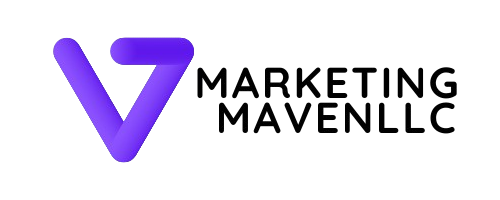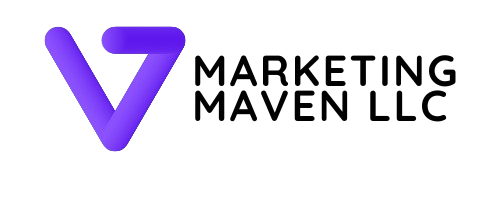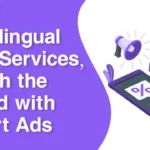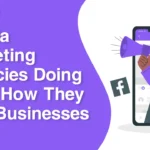If you’re stepping into the world of digital marketing, then there’s a high chance you’ve heard people talking about SEO short for Search Engine Optimization. But what is it, really? And more importantly, how does SEO work to bring people to your website?
Here at Marketing Maven, our mission is to make these things easy to understand. Whether you’re a beginner or someone looking to sharpen your skills, this guide will help you grasp the basics of SEO and how it plays a huge role in driving traffic, building online visibility, and getting long-term results all while introducing how AI and digital marketing are now working together.
What is SEO?
Let’s start with the basics.
SEO (Search Engine Optimization) is the process of increasing your website’s visibility in free or organic search results on search engines like Google, Bing, and even platforms like YouTube and TikTok. These aren’t paid ads instead, you earn your spot by creating high-quality content, making your website technically sound, and building trust with users and search engines.
Think of it like this: when you search something on Google, you’re more likely to click the top few results. SEO helps your website become one of those top results which means more people can find you, visit your site, and potentially become your customers.
As per a popular model called Mozlow’s Hierarchy of SEO Needs (inspired by Maslow’s Hierarchy of Needs), SEO is not just about keywords. It’s a whole structure that starts with basic technical needs and grows toward content quality, trust-building, and user satisfaction.
Quick Insight from Marketing Maven:
SEO isn’t just about Google anymore. People are now searching on social platforms too. Optimizing your content for YouTube, Instagram, and TikTok is also part of modern SEO.
The 3 Pillars of SEO
To understand how SEO works, you need to know its foundation. At Marketing Maven, we break SEO into three important pillars:
1. Technical Optimization
This is the part of SEO that happens behind the scenes. You might not see it on the page, but it’s crucial for search engines to crawl and index your website properly.
Examples include:
- Submitting your sitemap to Google
- Improving page speed
- Using mobile-friendly design
- Fixing broken links
2. On-Page Optimization
This pillar is all about the content on your website. It includes writing content that’s useful, using the right keywords, placing them naturally in titles, descriptions, and headings, and making the user experience smooth.
CMS platforms like WordPress, Wix, and Shopify make it easier to manage content and apply on-page SEO settings.
3. Off-Page Optimization
This is the part of SEO that focuses on outside signals mainly backlinks (links to your site from other websites). When other trustworthy websites link to yours, it tells Google that your site is valuable and credible.
It also includes:
- Social media mentions
- Influencer collaborations
- Online reviews and reputation
Paid Search vs. Organic Search: What’s the Difference?
When you’re aiming to grow online, you’ll come across two big options: Paid Search and Organic Search. It’s important to know how both work, especially if you’re planning your SEO strategy with Marketing Maven.
🔹 Position
Paid results show at the very top of search engine result pages (SERPs) with a “Sponsored” label. Organic results, powered by SEO, appear below those ads.
For example, if you search “best water bottle,” you’ll first see ads, then the SEO-ranked pages.
🔹 Time
Paid search is fast. You can run a campaign today and get results tomorrow. But with organic SEO, results come gradually sometimes weeks or months later. However, they tend to be more stable and long-lasting.
🔹 Payment
With paid search (like Google Ads), you pay every time someone clicks on your ad — this is called Pay-Per-Click (PPC) or Cost-Per-Click (CPC).
On the other hand, organic traffic is free, but you have to invest your time, strategy, and effort to grow it.
🔹 ROI (Return on Investment)
Paid search gives measurable results quickly, but can get expensive over time. Organic search, while slower, gives better ROI in the long run as your traffic becomes more stable and less dependent on ad budgets.
🔹 Share of Traffic
According to BrightEdge research, organic search drives 53% of all website traffic, while paid ads bring only about 15%. So if you want the bigger slice of the pie, SEO is where you invest.
Similarities Between Paid and Organic Search
Although different in how they work, both paid and organic search share some common ground:
- Keyword Research: Both need you to know what people are searching. Tools like Google Keyword Planner and Ubersuggest help you find high-performing keywords.
- Landing Pages: Whether it’s SEO or PPC, you need high-quality landing pages that match the user’s intent.
- User Intent: In both cases, the goal is the same give users what they’re searching for, in the most helpful and relevant way.
How Do Search Engines Actually Work?
In the world of digital marketing, one of the most important things to understand is how search engines like Google actually work. Whether you’re starting a blog, running an online store, or offering services, it’s search engines that help people discover your website. But how do they do it?
Let’s break it down in a simple and clear way just like we do at Marketing Maven, where we help beginners and businesses grow with smart SEO strategies.
What Exactly is a Search Engine?
A search engine is a special kind of website (like Google, Bing, or Yahoo) that helps people find answers to their questions. When someone types in a query, like “best pizza near me” or “how to lose weight,” the search engine looks through millions of web pages and shows the most helpful results.
But here’s the twist: those results don’t appear randomly. There’s a complete process going on behind the scenes that decides which page comes first and why.
The 3 Main Steps of How Search Engines Work
Step 1: Crawling (The Discovery Phase)
This is the first job a search engine does. It sends out tiny digital bots called crawlers, spiders, or Googlebots that go from one web page to another. Think of these bots like explorers searching the internet to find new pages or checking if any old pages have been updated.
For example, if you just posted a new blog on your website, and it’s linked from your homepage, these bots will follow the link and discover your blog. That’s how Google even knows it exists.
Crawling happens constantly because the internet keeps changing. So it’s important to make sure your website is easy to crawl and yes, Marketing Maven helps with that too through technical SEO.
Step 2: Indexing (The Storage Room)
Once a crawler visits a page, it decides whether to save it in Google’s database, called the index. Only good-quality pages make it to this storage room.
Here’s what helps your page get indexed:
- Your content must be unique
- It should have value, not just fluff or spam
- It must be accessible (not blocked by your settings)
- It should have links from other pages
If your page is copied from somewhere else or offers nothing useful, Google might skip adding it to its index.
💡 Pro Tip from Marketing Maven: To check which of your pages are indexed, type
site:yourwebsite.comon Google. You can also use the Google Search Console to get a full report.
Step 3: Ranking (The Real Battle Begins)
After your content is crawled and indexed, now comes the ranking phase. This is the most important step because ranking decides where your page shows up in search results.
Google uses more than 200 ranking factors, and most of them fit into the three pillars of SEO:
- Technical Optimization
- On-Page Optimization
- Off-Page Optimization
Here are some major signals Google looks at while ranking:
- Keywords in your titles and headings
- Website loading speed
- Mobile-friendliness
- Backlinks (how many good websites link to your content)
- User experience (how easy and helpful your content is)
- Content quality and relevance
And remember: The better your content satisfies the user’s intent, the higher your chances of ranking.
How Does Google Decide the Order of Results?
Google doesn’t use just one formula it uses a mix of powerful algorithms, including:
RankBrain
This is Google’s AI system that tries to understand the meaning behind a search. For example, if someone types a strange or new phrase, RankBrain figures out what they might mean by connecting it with similar searches in the past.
Instead of focusing only on keywords, RankBrain rewards content that truly satisfies the person searching.
That’s why user engagement, time spent on site, and click-through rate matter a lot.
Panda
This algorithm fights against low-quality content. If your site has duplicate or spammy content, Panda pushes it down the rankings.
Hummingbird
This helps Google better understand full questions and natural language not just specific words.
All of these work together to give users the best and most relevant answers.
What is EEAT and Why It Matters?
Google also looks at your website’s EEAT:
- Experience: Do you or your brand have real-world knowledge of the topic?
- Expertise: Are you or the author skilled in the subject?
- Authoritativeness: Is your site seen as a leader or trusted name?
- Trustworthiness: Is your content accurate and honest?
This isn’t a direct ranking factor, but it helps Google decide if your page deserves to rank especially for health, finance, or news-related topics.
At Marketing Maven, we help you build trust and expertise into your content because Google isn’t just looking at your keywords, it’s looking at your credibility.
New Tech: What’s Google MUM and Gemini?
Google is constantly evolving, and it has introduced AI-powered tools to make search results even smarter.
- MUM (Multitask Unified Model) understands questions across different languages, formats (like text and images), and provides more complete answers.
- Gemini (previously Bard) is a chatbot powered by Google’s latest AI that helps users find information in a more conversational way.
💡 Marketing Maven Tip: As search evolves, don’t just optimize for keywords. Optimize for conversations, questions, and context. That’s the future of SEO.
Thoughts by Marketing Maven
Search engines may seem complicated, but they follow a clear path: Crawl → Index → Rank. When you understand this process, you’re already ahead in the game.
At Marketing Maven, we specialize in helping businesses make the most of this system. Whether it’s making your site easier to crawl, writing content that ranks, or improving your brand’s authority we’ve got you covered.
Stay tuned for the next section, where we’ll explain how to build an SEO strategy that brings in more visitors, more engagement, and more results.
How to Get the Most Out of RankBrain
If you want your website to rank higher on Google, understanding RankBrain is no longer optional it’s essential. Google’s RankBrain is part of their smart AI system that helps decide which web pages deserve to appear at the top of search results. And at Marketing Maven, we believe that a strong SEO strategy must include steps to impress RankBrain because it rewards the websites that satisfy the user’s needs the most.
So how do you do that? Let’s break it down into clear, easy-to-follow steps.
1. Focus on Long-Tail and Medium-Tail Keywords
Instead of targeting just one-word keywords (which are super competitive), go for long-tail keywords like “best SEO tools for beginners” or “how to increase website ranking fast.” These keywords show strong intent and are easier to rank for. They also help you attract quality organic traffic that’s more likely to convert.
2. Use Natural Language
Write your content the way people talk. Don’t make it robotic or filled with technical jargon. RankBrain understands conversational tone, so your blog or service page should sound like a real person is explaining something clearly. This also boosts user satisfaction, which is a key factor in ranking.
3. Optimize Titles and Meta Descriptions
The click-through rate (CTR) is an important signal. It shows Google that people are interested in your content. Make your titles catchy but relevant. And your meta descriptions? They should tease the reader enough to make them click. At Marketing Maven, we test multiple variations to see which ones pull in more visitors.
4. Increase Dwell Time & Reduce Bounce Rate
Dwell time is the amount of time a visitor spends on your site before going back to search results. The longer they stay, the more useful your content appears to Google. If someone lands on your page and immediately leaves, that’s called a bounce and it sends a bad signal. So what’s the fix?
- Break up long text with headings and images
- Add videos that explain your product or service
- Include expert quotes, tips, or FAQs
- Use interactive elements like polls or quizzes
These not only engage users but also increase your page authority.
What is an SEO Strategy?
Think of an SEO strategy as a roadmap for ranking success. Just like you need a clear plan to grow your business, you need a structured approach for SEO. The goal? Rank higher in search results, get more organic traffic, and bring the right visitors to your website.
A smart SEO strategy ensures you’re not wasting time and money creating content that doesn’t work. It helps you focus on performance-driven content that connects with your target audience and gets results.
And if you’re a small business? Then local SEO should be part of your strategy. Why? Because people nearby are already looking for businesses like yours. With the right tweaks, you can become their go-to choice.
How to Set Clear SEO Objectives
Having a strategy without goals is like sailing without a compass. Setting clear SEO objectives makes your efforts measurable and impactful. These objectives also help align your SEO with your overall business goals, so everyone from your team to stakeholders is on the same page.
Here’s why setting SEO goals is important:
- They guide your planning
- They help you focus on what really matters
- They make it easier to measure your success
What Metrics Should You Track in Your SEO Strategy?
To know if your SEO strategy is working, you need to track the right SEO metrics. Let’s go over each one and what it tells you:
Top of the Funnel (TOFU) – Awareness Stage:
- Keywords – These are the terms your audience types into Google. Track which ones you rank for and how well they perform.
- Organic traffic – This shows how many people are visiting your site through search results. More organic traffic = stronger SEO.
- SERP position – The higher you appear in Search Engine Results Pages (SERPs), the more clicks you’ll likely get.
- Click-through rate (CTR) – How many people click on your site when they see it on Google? This metric reflects how attractive your listing is.
- Brand awareness – Are more people recognizing your business name online? Good SEO builds brand familiarity.
- Domain authority – This score predicts how likely your website is to rank. More authority = more trust from search engines.
Middle of the Funnel (MOFU) – Interest & Engagement Stage:
- Time on page – This tells you how long people are staying. Longer time means your content is useful.
- Engagement rate – Do users scroll, comment, or share? Higher engagement = better content quality.
Bottom of the Funnel (BOFU) – Conversion Stage:
- Leads and revenue – At the end of the day, how many leads or sales are coming from your SEO efforts? Link your SEO performance to income, and you’ll know what’s working.
Real Examples of SEO Objectives Set the Right Goals with Marketing Maven
Setting clear goals is one of the most important steps in building a successful SEO strategy. But if you’re just starting, don’t expect your site to jump to #1 overnight. At Marketing Maven, we always say: Start with realistic numbers, then aim higher with smart planning.
If you’re new to SEO and have no previous data, your first targets should be modest. As you grow and learn what works, your future goals can be more ambitious and data-driven. But setting goals too high, too soon? That just leads to frustration.
Here are 3 smart SEO objectives you can use as inspiration:
- Move 50% of your top 20 keywords to Google’s first page within nine months.
→ This target is focused on keyword ranking and helps improve your visibility. - Increase year-over-year organic traffic by 20% in Q3 and 25% in Q4.
→ This one tracks your growth in organic website traffic over time. - Grow your SEO market share from 3% to 5% by next year.
→ This focuses on expanding your brand’s presence in the competitive space.
At Marketing Maven, we help clients build measurable SEO goals that actually make sense for their industry, location, and budget. Whether you’re a small startup or an established business, goal-setting is where real SEO begins.
SEO Goals Based on Your Business Type
Every business is different, so your SEO objectives should match your business model.
If your business is transactional (like an e-commerce store), your focus should be on sales, lead conversions, and product visibility. You’ll want to track things like add-to-cart clicks, checkout rate, and how many users convert from SEO-driven traffic.
If your site is non-ecommerce but commercial (like a service provider), you should focus on lead generation. This might include tracking form fills, quote requests, or bookings coming from search traffic.
If your business is informational, such as a blog, news platform, or knowledge resource, then your goals will likely center around increasing brand awareness, website visits, and content engagement.
And remember SEO is not a “set it and forget it” game. Even when your strategy is in place, you’ll need to adapt over time. Google’s algorithms change. Competitors rise. So your SEO plan should be flexible, long-term, and always ready to evolve.
Want to Become an SEO Specialist? Here’s How
Now that you understand what SEO is and how it works, maybe you’re thinking about turning this knowledge into a career. Great idea! Companies in every industry are looking for people who can drive organic traffic and improve their online presence.
A 2025 report by Conductor found that 91% of marketers said SEO helped them hit their goals. And across every role, increasing brand visibility through SEO is seen as a top priority.
So what do you need to learn if you want to become an SEO expert? Let’s dive into the skills that matter.
Skills You Need to Become an SEO Specialist
At Marketing Maven, we believe a good SEO expert should have both technical and creative skills. Here’s a complete breakdown:
Keyword Research
You must know how to find high-value keywords terms that your audience is actually searching for. These keywords help your content rank higher and reach the right people.
Link Building Strategy
Learn how to use both internal links (links within your site) and external backlinks (from other websites) to build your site’s reputation. Backlinks are a huge trust signal to Google.
Content Optimization
Your content needs to be helpful, clear, and easy to read. Learn how to create content pillars, update older articles, and make your blogs SEO
ready.
Data Analysis
SEO is powered by numbers. You need to track what’s working and what’s not. Tools like Google Analytics, Search Console, and Ahrefs will become your best friends.
Copywriting & Content Marketing
Being able to write clearly is a big plus. Good copy helps with click-through rate, dwell time, and overall engagement. The better your writing, the more users trust you.
Technical SEO
You should also understand the back-end stuff:
- Page speed optimization
- Fixing broken links
- Structured data
- Mobile responsiveness
These things help search engines understand and rank your site properly.
💡 Soft Skills Matter Too
Aside from technical knowledge, an SEO expert needs strong communication, critical thinking, and the ability to work in a team. Whether you’re working in an agency or freelancing, these skills help you succeed.
How Much Can You Earn as an SEO Specialist?
So, you’re thinking about making a career in SEO? That’s a smart move. Not only is Search Engine Optimization one of the most in-demand skills in digital marketing, but it also comes with solid earning potential whether you work as a freelancer, at an agency, or full-time in-house.
At Marketing Maven, we’ve seen first-hand how SEO professionals can shape the growth of businesses and their own careers too. Your salary will depend on three main factors:
- Your experience level
- The type of role you choose
- Your location
Let’s look at what professionals are earning in different parts of the world.
SEO Salary in the United States (per year)
According to Search Engine Land:
- Entry-level SEO Specialist: $49,000 – $72,000
- SEO Analyst/Executive: $62,000 – $101,000
- SEO Strategist: $69,000 – $110,000
- SEO Manager: $80,000 – $120,000
- Head of SEO: $109,000 – $192,000
As you can see, there’s big potential to grow your income as your skills and experience develop.
SEO Salary in the UK (per year)
Based on Indeed.com reports:
- Junior SEO Specialist: £23,642
- SEO Executive: £25,555
- SEO Content Strategist: £35,811
- SEO Manager: £37,531
- Senior SEO Specialist: £42,678
This shows a clear path from beginner to expert and the income rise that comes with it.
SEO Salary in Ireland (per year)
According to Irish estimates on Indeed.com:
- SEO Executive: €31,031
- SEO Specialist: €47,864
- Senior SEO Specialist: €61,169
- SEO Manager: €54,077
Whether you’re working from Ireland, the UK, or the US SEO is a rewarding career financially, especially if you keep up with trends and continue sharpening your skills.
Best SEO Tools to Supercharge Your Growth
To become a great SEO expert, you need the right tools not just talent. At Marketing Maven, we recommend a combination of free and paid tools depending on your project scale.
Ranking & Reporting Tools:
- Google Search Console
- GA4 (Google Analytics 4)
- KWFinder
- SemRush
- Page Speed Insights
SEO Audit Tools:
- Screaming Frog
- SEOptimer
- Moz
Keyword & Content Research:
- Google Keyword Planner
- AnswerThePublic
- Ubersuggest
- BuzzSumo
AI Tools for SEO:
- seoClarity
- Surfer SEO
Using these tools the right way can help you analyze rankings, fix issues, generate keyword ideas, and track real results. This is how we do it at Marketing Maven, and it’s how we help our clients stay ahead.
The Future of SEO: Powered by AI
Artificial Intelligence is quickly transforming the way SEO works. From creating content to predicting user intent, AI is now involved in almost every stage of the process. Here are some big developments you need to watch:
Emerging AI Trends in SEO:
- Google’s AI Overviews (SGE) – These are advanced featured snippets that generate detailed answers using AI. Think of it as search + chatbot + carousel all in one.
- Predictive Analytics – Tools like RankSense, Ahrefs, and CognitiveSEO use AI to spot upcoming trends and help you stay ahead of algorithm updates.
- AI in Local SEO – Tools like Moz Local and BrightSpark optimize your content for regional searches.
- Answer Engine Optimization – Users are now asking questions to tools like ChatGPT and Google SGE, so you need to format your content for direct answers.
- Video SEO – With platforms like YouTube booming, optimizing videos for keywords and watch-time is essential.
- Core Web Vitals (CWV) – These metrics include page loading time, visual stability, and interactivity. Improving them boosts both SEO rankings and user experience.
Why Choose SEO as a Career?
Doing SEO is not just about tweaking websites it’s about understanding what users want, creating value, and helping brands connect with the right audience. If you’re analytical, creative, and love the internet this might be the perfect career path for you.
And guess what? You don’t need a university degree to become successful. You need skills, smart tools, and continuous learning. The best part? You can freelance, work from home, join a top agency, or even start your own SEO consulting firm like Marketing Maven.
Marketing Maven Tip 💬
Learning SEO doesn’t mean you need to master everything at once. Start with basics then specialize. You could focus on technical SEO, or become a content optimization pro. What matters is consistent learning and real-world experience.
Need help building your first SEO campaign? Want to train with experts? Join forces with Marketing Maven we’ll guide you, mentor you, and help you grow your skills the smart way.
Ready to master the art of SEO and grow your career or business online? Join Marketing Maven’s Professional SEO Training Program a step-by-step course designed for beginners and growing marketers alike. Learn keyword research, technical SEO, link building, AI integration, and more. With real-world projects, expert mentorship, and lifetime access, you’ll gain the tools and confidence to dominate search results.
